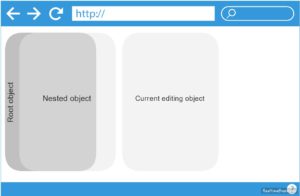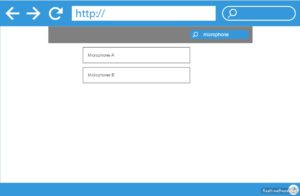smle /ˈsmaɪ.li/ is one of 52°North’s new developments. It is based on TypeScript and Angular 2 and enables web-based editing of SensorML descriptions. The implementation of this editor started earlier this year within the context of the projects NeXOS and FixO3. The idea of the Google Summer of Code activity is to enrich the editor with further functionality and to improve the usability in some aspects.
The following features are planned for this summer’s GSoC project:
- Improve the GUI structure: sensor descriptions can be very large and complex with many levels of nested objects. In order to hide this complexity from the user, we have to avoid visual nesting in the interface. To achieve this objective, the idea is to place nested visual elements not inside but next to the parent and on another layer. The concept is illustrated below:

- Connect the editor with Sensor Observation Service (SOS) servers: SOS servers offer the InsertSensor, UpdateSensor and DescribeSensor operations to create, modify and retrieve sensor metadata documents. Thus, the objective of this project is to enable the use of SOS servers to manage SensorML documents edited with smle.
- Design and implement additional UI controls with the following features:
- specific fields for concrete value types (number input for numbers, phone input for telephone numbers, calendar input for dates, etc.),
- validate input values to avoid errors and misspellings,
- interactive, graphical selection as an alternative to typing in complex data elements (e.g. pick a point or draw an area on the map instead of typing a series of coordinates),
- use autofill and autocomplete.

- Further small improvements such as hotkey support, quick search on the items, using local storage for persisting data, etc.

Some of these features will be implemented using existing open source JavaScript libraries such as Parsley and Leaflet, but several features need to be written from scratch, such as the new GUI concept.
The new editor will be used in several research projects:
- The NeXOS Project – Next Generation Web-Enabled Sensors for the Monitoring of a Changing Ocean;
- FixO3 – Fixed point Open-Ocean Observatories;
- BRIDGES – Bringing together Research and Industry for the Development of Glider Environmental Services.
At the end of the summer we expect a SensorML editor with improved usability, as well as additional functionality, which can be freely used for editing sensor descriptions not only in the mentioned projects. The progress of this project can be followed on the GitHub repository and Wiki page.
About me
I am Aleksandr Shevchenko, a second year Master student of Computer Science at the faculty of Mechanics and Mathematics of Perm State University, Russia. For a couple of years I have been writing programs using C# and .NET. However, as a Web developer I’m also interested in cutting edge technologies and frameworks such as Angular 2 and TypeScript.
I like to create useful software products which will help people to solve their problems. I enjoy developing user interfaces which are convenient and pleasant to use. I want to contribute to open source software to spread the benefit of using it to a lot of people.
Leave a Reply